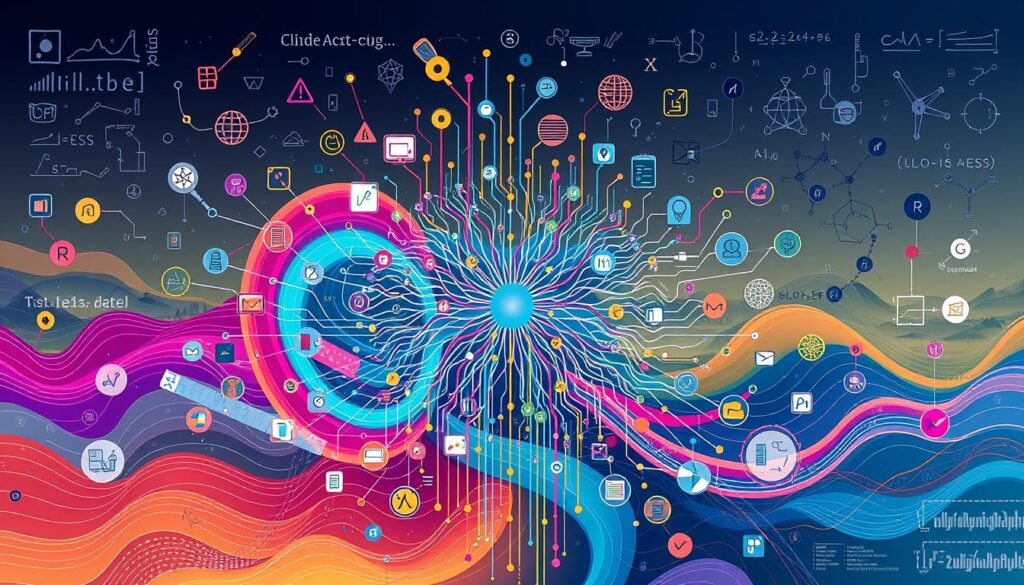Is mastering Machine Learning (ML) the key to unlocking the future of innovation? This guide will help you learn the basics and grow in the ML field. It focuses on Artificial Intelligence (AI) to help you solve problems and predict outcomes.
Whether you're new or looking to improve, this guide has what you need. It includes tips and resources from Coursera, edX, Gartner, and McKinsey. Stay ahead with the latest in ML.
Key Takeaways
- Machine Learning is a vital skill in modern technology landscapes.
- Understanding Artificial Intelligence enhances your ML capabilities.
- Effective ML practices lead to improved problem-solving and predictive analytics.
- Reputable platforms provide valuable resources for learning.
- Industry reports offer insights into the latest trends and developments in ML.
Understanding the Basics of Machine Learning
Machine Learning (ML) is a big step in technology. It lets systems get better with more data. Knowing the basics of ML is key for anyone interested in it. This part will cover what ML is and its main ideas.
What is Machine Learning?
Machine Learning is a part of Artificial Intelligence. It makes systems that learn from data. Unlike old programming, ML uses stats to get better with more data. This makes it useful for many things like predicting and doing things on its own in fields like health, money, and tech.
Key Concepts and Terminology
The Basics of ML include important ideas. These ideas help us understand how these systems work. Here are some basic terms:
| Term | Description |
|---|---|
| Model | A math way to guess what will happen based on data. |
| Algorithm | Rules or math to solve problems or do tasks. |
| Features | Things we can measure that help train models. |
| Training Data | Data used to teach models to make guesses. |
| Supervised Learning | Learning from data with answers, making guesses based on that. |
| Unsupervised Learning | Finding patterns in data without answers. |
The Role of Artificial Intelligence in Machine Learning
Artificial intelligence (AI) and machine learning (ML) work together well. AI makes ML better by using smarter algorithms. This helps systems to understand big data, make quick choices, and do tasks on their own.
How AI Enhances ML Capabilities
AI is key to making ML better. It brings new tools and ways to work. This leads to big improvements.
- Neural Networks: These models are like the human brain. They help find patterns in data.
- Natural Language Processing (NLP): This lets machines understand and talk like humans.
- Computer Vision: This lets machines see and understand pictures and videos.
These technologies show how AI helps ML. They make machines smarter and better at making choices.
Differences Between AI and ML
AI and ML are not the same. AI is about making machines smart like humans. ML is about using data to learn and get better.
| Aspect | AI | ML |
|---|---|---|
| Scope | Broad technology for intelligent systems | Subset focused on learning from data |
| Application | Includes robotics, computer vision, NLP | Predictive analytics, classification, clustering |
| Goal | Simulate human-like cognition | Optimize performance based on data input |
AI and ML work together to make technology better. They help us understand how to use data to get better results. This teamwork drives new ideas and changes how we use data.

Data Science: The Backbone of Machine Learning
Data is key in Machine Learning. It's what makes models work well. Different kinds of data help us understand things better and make good choices.
The Importance of Data in ML
Good data is needed for Machine Learning to work right. It must be collected well. If not, we might get wrong answers.
Data Preprocessing Techniques
Getting data ready for Machine Learning is important. It makes sure the data is clean and ready to use. We use different ways to do this, like:
- Data Cleaning: Getting rid of bad data and fixing mistakes.
- Normalization: Making sure all data is the same size.
- Feature Extraction: Picking the most important parts of the data.
Using these steps helps make sure our data is good for Machine Learning. This leads to better results.
| Data Type | Description | Examples |
|---|---|---|
| Structured Data | Organized data found in places like databases. | SQL databases, spreadsheets. |
| Unstructured Data | Data that doesn't follow a set pattern. | Text documents, images, videos. |
| Semi-Structured Data | Data that has both structured and unstructured parts. | JSON files, XML data. |
Types of Machine Learning Algorithms
It's key to know the different ML algorithms. There are two main types: Supervised Learning and Unsupervised Learning. Each type is used for different tasks with data.
Supervised Learning Explained
Supervised Learning uses labeled data. The model learns to predict based on what it's shown. For example, it can sort emails into spam or not.
Another example is using it to guess sales numbers from past data. This is called regression.
Unsupervised Learning Overview
Unsupervised Learning works with data that isn't labeled. It finds patterns and groups data without labels. Clustering is a good example of this.
It helps businesses understand their customers better. This way, they can make their products more appealing. Knowing about these algorithms helps us see how they work in real life.

Deep Learning and Neural Networks
Deep learning is a big step in machine learning. It uses neural networks like our brains. These networks have layers, nodes, and connections. They help process lots of data in complex ways.
Knowing how neural networks work is key. It helps us use deep learning in many fields.
Understanding Neural Networks
Neural networks are like our brains. They have nodes that connect to each other. They have:
- Input Layer: Gets the first data.
- Hidden Layers: Does the hard work.
- Output Layer: Shows the final answer.
Each connection has a weight that changes during learning. This makes the network better. There are special networks for images and words.
Applications of Deep Learning
Deep learning is used in many areas. It's really good at:
- Computer Vision: Helps with faces and cars.
- Natural Language Processing: Makes talking to machines better.
- Healthcare: Helps with pictures and patient care.
Deep learning makes things better and faster. It's changing how we do things. More research is always finding new ways to use it.
Machine Learning (ML) Tools and Frameworks
Learning about ML Tools and Frameworks is key for machine learning beginners. The world of data is growing fast. This means we need advanced tools for analysis.
Popular Libraries for ML
Many libraries are important for machine learning. TensorFlow, made by Google, is very flexible. It works well for big and small projects.
PyTorch, from Facebook, is great for building models. It makes it easy to see and fix problems in your code.
Scikit-learn is simple and works well for classic algorithms. It's easy to use with other Python tools. Keras makes deep learning easier. XGBoost is fast and good for boosting.
Choosing the Right Framework for Your Project
Choosing the right framework depends on several things. How easy it is to use and how well it scales are important. TensorFlow is great for big projects. PyTorch is better for research.
Think about what your project needs. If you have big data and need it to work well, TensorFlow might be best. For quick tests, PyTorch could be better.
Using GitHub and library guides can help you decide. They offer real examples and tips. Choosing the right tool can help you succeed in machine learning.
Predictive Analytics: Harnessing the Power of ML
Predictive analytics changes how we look at data. It uses ML to give us insights for making smart choices. By looking at past data, it helps us guess what will happen next.
It uses special tools like regression analysis and decision trees. These tools help find patterns and predict what will happen.
What is Predictive Analytics?
Predictive analytics is all about finding trends and predicting the future. It uses ML to look at lots of data. This way, businesses can make better choices based on facts, not just guesses.
This method makes things run smoother and better in many areas.
Real-world Applications of Predictive Analytics
Predictive analytics is used in many fields. In finance, it helps banks know who to lend to and spot fraud. This makes things better for customers.
In healthcare, it helps guess who will need to go to the hospital. This helps doctors plan better. Marketing teams use it to make ads that people will like more. This makes people more interested in what they're selling.
Studies show how great predictive analytics is. McKinsey & Company found that using predictive models makes customers happier and things run better. This shows why businesses should use it to grow.
Natural Language Processing in Machine Learning
Natural Language Processing (NLP) is where machine learning meets human language. It lets machines understand and talk like us. This tech is key for businesses to talk to customers better.
Introduction to NLP
NLP uses many ways to make machines understand and create human language. It looks at words, meaning, and how we talk. Thanks to machine learning, NLP gets better at knowing what we really mean.
Applications of NLP in Business
Many businesses use NLP to talk to customers better and work smarter. Here are some ways they use Applications of NLP:
- Sentiment Analysis: Amazon checks what people think about their products. They change things based on what customers say.
- Chatbots: Microsoft's chatbots help customers with questions and problems. They work really well.
- Language Translation: Google Translate helps businesses talk to people in different languages. It lets them reach more people.
NLP changes how businesses work and make customers happy. It's making business talk better for everyone.
Algorithm Optimization for Improved Performance
In machine learning, making algorithms better is key. Techniques like hyperparameter tuning help a lot. They adjust model settings to get the best results.
Feature selection also plays a big role. It picks the most important data inputs. This makes the data better and saves computer time. These steps really make a difference in how well a model works.
Ensemble methods are another way to improve. They mix different algorithms for better predictions. This makes the model more reliable and accurate.
These methods are used in real life too. For example, in fighting fraud and making recommendations. They help a lot in making predictions more accurate and faster.
Experts say we always need to keep making algorithms better. As data gets more complex, we must keep optimizing. This keeps our models performing well.
By always improving our models, we stay ahead. In a world where being fast and accurate is important, this is crucial.
